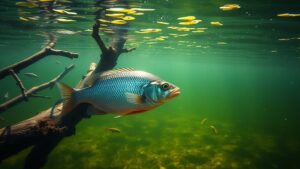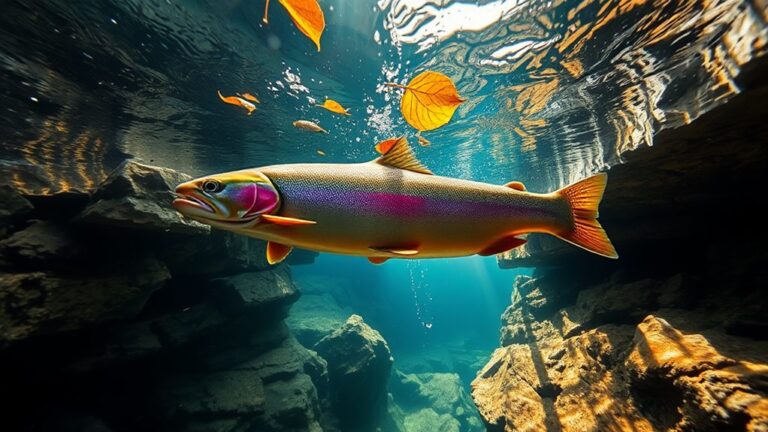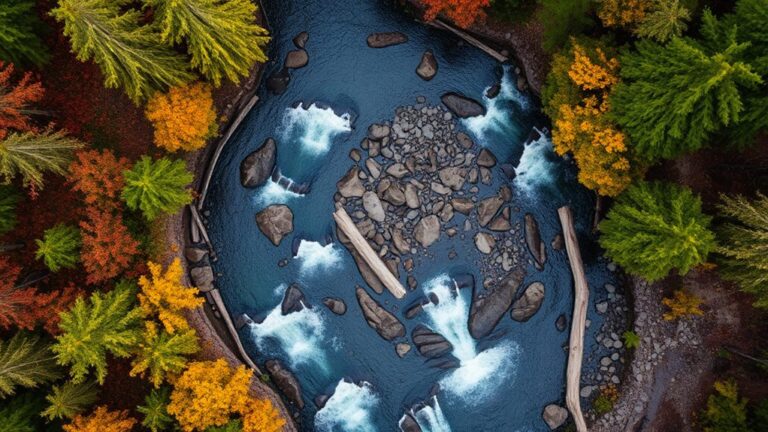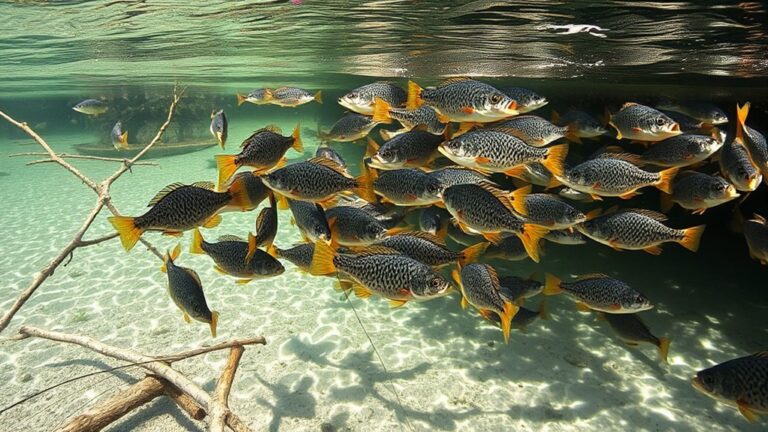To catch more crappie in shallow spring waters, target areas where water temperatures reach 60-70°F, focusing on depths of 4-5 feet near brush piles and flooded timber. You'll want to use a 5.5 to 6-foot rod with 4-pound test line, rigged with a 1/32-ounce jig in hot pink or chartreuse. Position your stand-up bobber 1.5 to 2 feet above the jig, and fish during early mornings or late evenings when crappie are most active. Keep a low profile, use polarized sunglasses to spot beds, and pay attention to weather patterns – particularly during overcast days or light rain. Understanding these spawning habits and seasonal patterns will reveal even more successful fishing strategies.
Understanding Spring Water Temperatures
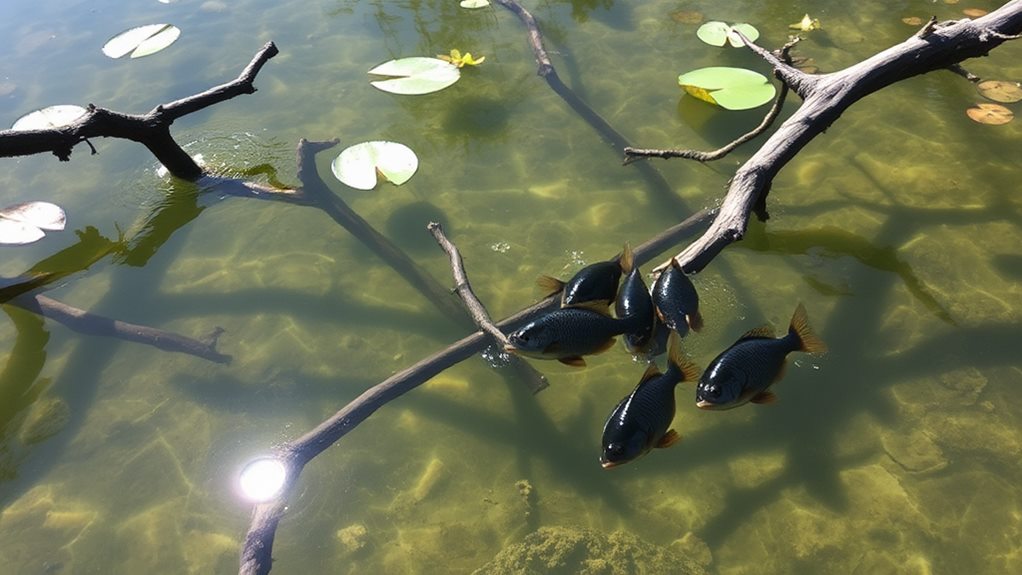
Tracking water temperatures is crucial for successful spring crappie fishing. You'll notice distinct patterns in crappie behavior as the waters warm up, making temperature your most reliable guide for finding these popular panfish. When temperatures hit 45-50°F, crappies start their journey from winter hideouts, and you'll find them gathering near creek channel entrances.
As spring progresses, you'll want to follow the crappies' movement patterns closely. Once the water reaches 55-60°F, these fish will migrate to shallower areas as they prepare for spawning.
It's significant to consider that Black and White Crappie have slightly different preferences, with Black Crappie typically spawning in cooler waters.
Watch for temperature drops during cold fronts, as they can throw off your fishing game. When temperatures plummet from 65°F to 62°F, crappies often pause their spawning activities, which affects their movement and your catch rates.
The sweet spot for spawning activity falls between 60-70°F, with peak action occurring in the 62-65°F range. Keep a water thermometer handy – it's your best tool for predicting where these spring crappie will be staging.
Essential Gear and Equipment Setup
When gearing up for spring crappie fishing, you'll want to start with an ultra-light setup featuring a 5.5- to 6-foot rod paired with 4-pound test line. This combination provides the perfect balance of sensitivity and control, helping you detect even the subtlest bites in shallow waters.
Your vital gear should include 1/32-ounce jigs in hot pink or chartreuse colors, which are proven crappie attractors during springtime. While live minnows can work, you'll often get better results by tipping your jigs with 2- to 2.5-inch Mister Twister Sassy Shad. These artificial baits provide more consistent action and are easier to manage than live bait.
Don't overlook the importance of a quality bobber setup. Position a stand-up bobber about 1.5 to 2 feet above your jig to maintain visibility while allowing for natural bait presentation.
For the best results, include specialized equipment like Super-Pro Lite-Bite Slip Bobbers in your tackle box. These advanced bobbers enhance bite detection and visibility, especially during those prime low-light fishing periods when crappie are most active.
Finding Prime Spawning Locations
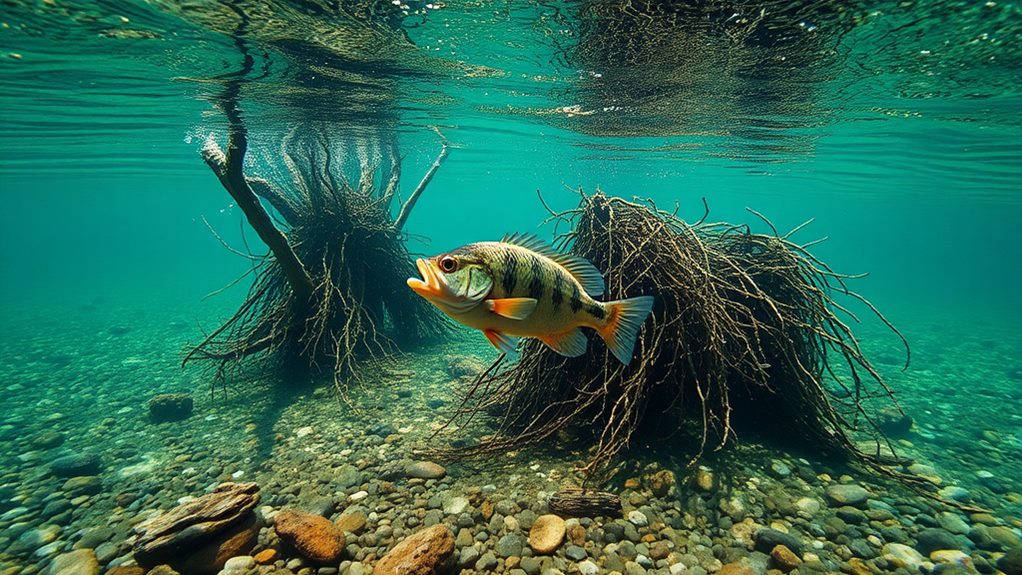
Three key features signal prime crappie spawning locations in spring: shallow waters around 4-5 feet deep, firm bottom structure, and abundant cover like Cabbage Weed.
You'll want to focus your search on areas where these elements come together, particularly in flooded woodlands and brushy spots where crappies can protect their nests.
To locate these prime spawning locations, keep an eye on your water temperature gauge – when it hits between 60-70°F, you're in business.
The males will move in first to establish nesting sites, followed by the females.
Creek channels are your roadmap to success, as they serve as natural highways leading crappies to their shallow water spawning grounds.
Don't forget to leverage technology in your search.
A quality fish finder or bottom-contour map can reveal hidden structures and depth changes that might otherwise go unnoticed.
When you spot rising water levels coinciding with ideal temperatures, you've hit the sweet spot.
Keep track of successful spots – these spawning locations often remain consistent from year to year, making them reliable honey holes for future spring fishing adventures.
Best Times To Fish
During the spring spawn, timing your fishing trips around peak crappie activity can dramatically improve your catch rate. For the best times to fish, you'll want to focus on early mornings and late evenings, with some of the most productive fishing happening just as the sun starts to set. These periods naturally align with when spring crappies are most active.
Temperature plays an important role in determining prime fishing windows. You'll find crappies moving into shallow waters once temperatures climb above 55°F, with Black Crappie beginning their spawn around 58°F and White Crappie following at about 62°F. The sweet spot for both species falls between 60-70°F, when they're most actively feeding and spawning.
Weather Conditions Matter:
- Overcast days are ideal for fishing
- Light rain can increase activity
- Water temps of 60-70°F are best
Pro Tip: Keep a fishing log to track water temperatures and weather conditions. You'll notice patterns emerging that can help you pinpoint the absolute best times to be on the water during spring.
When conditions align – comfortable temperatures, cloud cover, and dawn or dusk timing – you're set for an excellent fishing session.
Live Bait Versus Artificial Lures
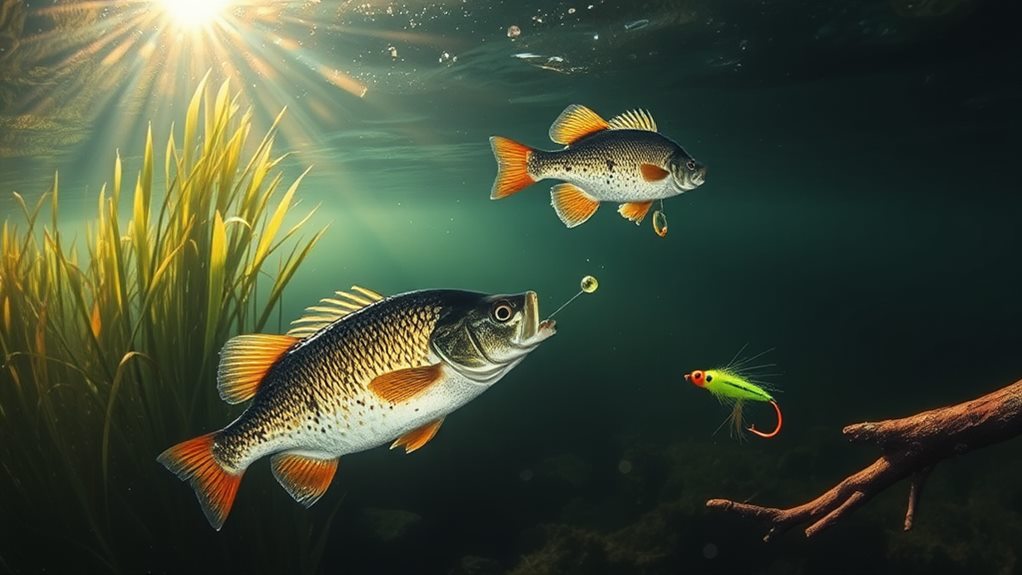
A crappie angler's age-old debate centers on choosing between live bait and artificial lures for spring fishing success. While live minnows often prove irresistible to spawning crappie due to their natural movement and scent, artificial lures offer versatility that shouldn't be overlooked.
Similar to optimal bass conditions, early morning and late evening provide prime feeding opportunities when using either technique. You'll find that both options have their time and place, depending on conditions and seasonal patterns.
When selecting your weapon of choice, consider these emotional factors:
- The heart-pounding thrill of watching a bobber disappear with live bait
- The satisfaction of mastering the perfect jig presentation with artificial lures
- The pure joy of discovering which technique works best on any given day
In murky water, you'll want to lean toward brighter artificial lures or glow-in-the-dark options that catch a crappie's attention.
However, during early spring, live minnows suspended 1.5-2 feet below a stand-up bobber often outperform artificials. As the season progresses and water warms, you can shift to artificial lures, which allow you to cover more water efficiently.
Stealth Fishing Approaches
Successful spring crappie fishing hinges on more than just choosing the right bait – it's about approaching your target without detection. Your success rate will greatly improve when you master the art of stealth fishing, starting with the right gear and techniques.
To enhance your stealth approach, you'll want to invest in polarized sunglasses, which cut through water glare and help you spot crappies before they spot you. When you've located your target, maintain a low profile and position yourself at a comfortable casting distance to avoid spooking the fish. Remember, these spring crappies are particularly skittish in shallow waters.
Your casting technique should be gentle and precise, allowing your lure to land softly on the water's surface. Focus on areas with natural cover, such as submerged brush piles or weed beds, where crappies often seek shelter during spring.
To maximize your stealth advantage:
- Use longer rods for distance casting
- Spool light lines to reduce visibility
- Move slowly and deliberately
- Minimize noise by avoiding sudden movements
- Position yourself downwind when possible
Reading Weather Patterns
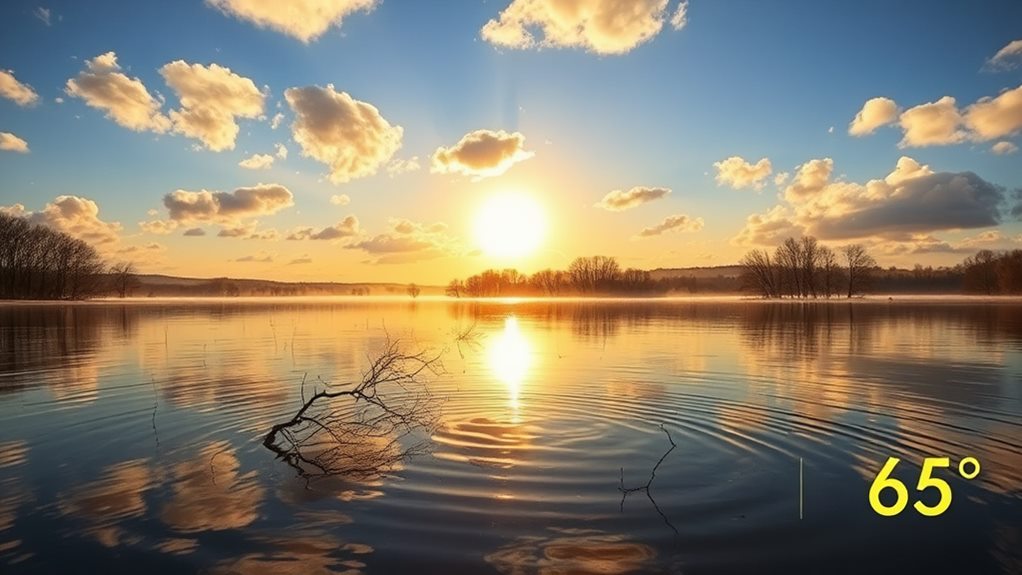
Weather patterns play a decisive role in spring crappie fishing success, as these fish respond dramatically to atmospheric changes. When you're planning your next crappie expedition, pay close attention to barometric pressure changes, which can signal prime fishing opportunities.
You'll find that falling pressure often triggers active feeding, while rising pressure can indicate excellent pre-spawn conditions. Post-storm fishing success peaks within three days as crappie return to normal feeding patterns.
Understanding these weather-related behaviors can transform your fishing success:
- Watch for overcast days, which create perfect conditions for shallow-water crappie action.
- Monitor approaching cold fronts that might push crappie into deeper waters.
- Track wind patterns to locate baitfish concentrations and find active crappie.
When you're on the water, remember that weather changes can quickly affect crappie behavior. If you notice a sudden temperature drop, don't hesitate to adjust your fishing depth accordingly.
The key is staying flexible with your approach – if warm fronts move in and water temperatures climb into the 60-70°F range, you'll want to focus on shallow areas where crappie gather for spawning.
Casting and Retrieval Methods
Perfect casting and retrieval techniques build on your weather pattern knowledge to maximize spring crappie catches. When fishing around isolated stumps and brush during the spawn, you'll want to slow down your retrieval to give these structure-loving fish a chance to strike. Your tackle selection plays a vital role in this approach.
Start by casting your jig and letting it sink to where you think the crappies are holding. Once it reaches the right depth, begin a gentle jigging motion with intermittent pauses – this natural presentation often triggers strikes from hesitant fish. For better control and bite detection, position a stand-up bobber about 1.5 to 2 feet above your jig.
When trolling, keep an eye on your bobber's position. A flat-lying bobber tells you you're moving at the perfect speed to entice those spring crappies.
Don't forget to experiment with your jig selection – 1/32oz jigs in hot pink or chartreuse often work wonders in shallow water. Remember, sometimes it's not about changing your casting technique but finding the right color and size combination that triggers those aggressive spring bites.
Float Selection and Positioning
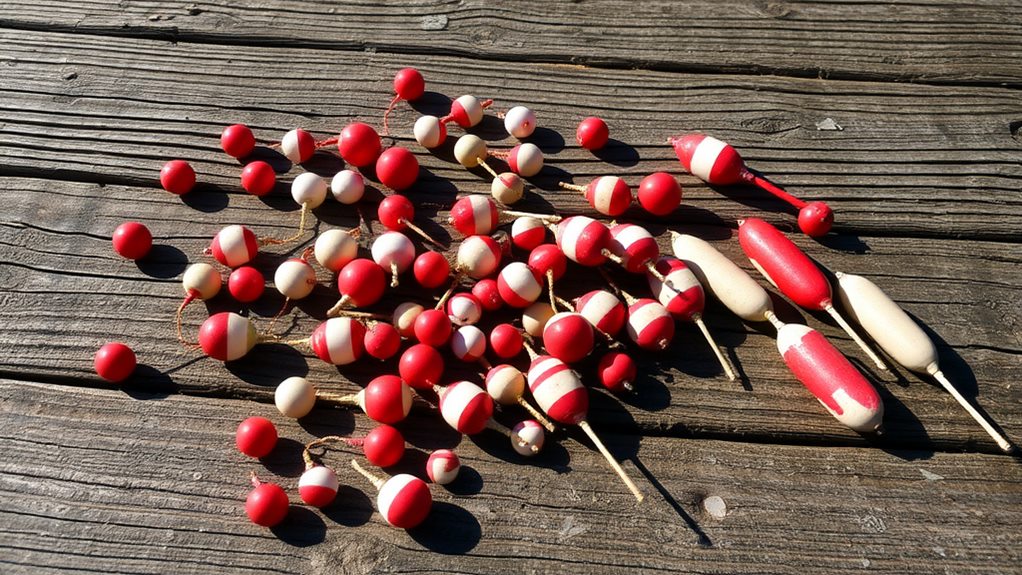
During spring crappie fishing, choosing the right float and positioning it correctly can make the difference between a good day and a great day on the water.
When it comes to float selection, you'll want to take into account factors like current strength and wind speed, especially in clear water conditions where presentation matters most. Lite-Bite Slip Bobbers are your best bet, as they offer minimal resistance when those finicky crappies take a nibble.
For best results, position your bobber 1.5 to 2 feet above your jig, keeping your bait in the prime strike zone where spring crappies are most active. Using bright-colored floats will help you spot even the subtlest movements when those light biters come calling.
Here's why slip cork rigs are particularly effective in spring:
- They allow for longer, more precise casts to reach those shallow spawning areas
- You'll achieve better bait presentation in varying depths
- They're especially effective when crappies are actively feeding near the surface
Frequently Asked Questions
How to Find Crappie in Shallow Water?
You'll find crappie by targeting 4-5 foot depths near weed beds and structure. Look for Cabbage Weed patches, use your fish finder, and troll slowly while casting jigs around cover during spring.
What Is the Best Bait for Crappie in the Spring?
You'll have great success using small 1/32-ounce Gypsi Jigs tipped with live crappie minnows. Try pink/white jigs during daylight and glow green in low light. Bug-A-Boo Jigs with marabou feathers work well too.
What Time of Year Do Crappie Go Shallow?
You'll find crappie moving shallow in spring when water temps hit 45-50°F. They'll start staging near creek channels in March, and they'll fully commit to shallow waters once temperatures reach 55-60°F.
What Depth Is Crappie in Spring?
You'll find crappie at 4-5 feet deep when they first move shallow in spring. As spawning begins and water hits 60-70°F, they'll move even shallower, typically nesting in 1-3 feet of water.

